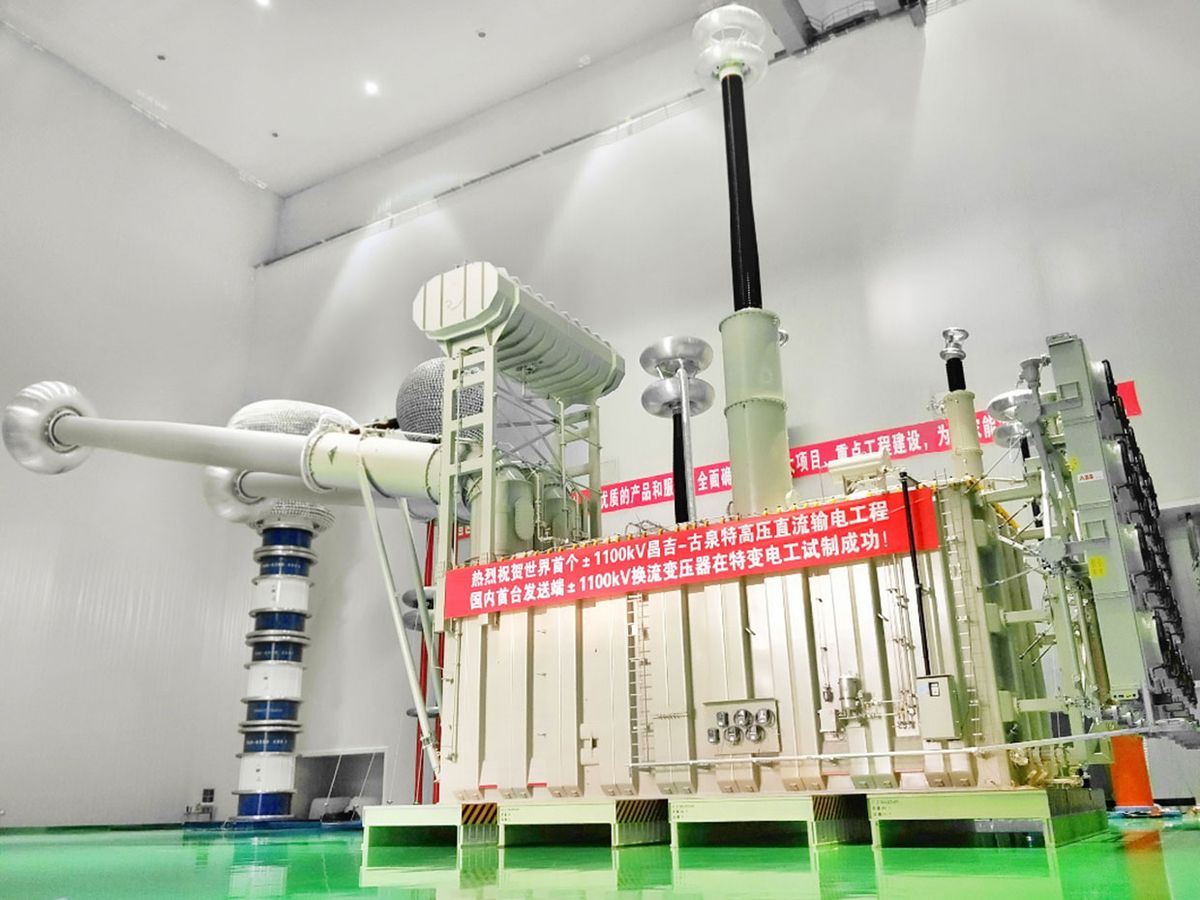China’s primary grid operator has energized its biggest and most powerful line yet, a 1.1-million-volt direct current (DC) behemoth that crushes world records for voltage, distance and power.
The new ultra-high voltage DC (UHVDC) line built by Beijing-based State Grid Corporation of China can transmit up to 12 gigawatts. That is enough to power 50 million Chinese households, according to a statement issued in Chinese by State Grid last week, and 50 percent more than most of the 800-kilovolt UHVDC lines that State Grid has built over the past decade.
The new 1100-kv UHVDC line absorbs the grid’s alternating current at an AC/DC converter station near the capitol of Xinjiang—China's vast northwestern territory—and sends DC power to a second converter station in Anhui province in eastern China. That 3,293 kilometer run extends power transmission’s distance record by over 900 kms.
State Grid dubs it the “Power Silk Road” in its statement because it follows the eponymous ancient route’s path through northwest China’s Hexi Corridor and can replace the equivalent of 25,000 coal trains’ worth of coal-fired generation in China’s heavily polluted eastern cities. In addition to battling air pollution, it could also deliver a hefty reduction in greenhouse gas emissions if State Grid prioritizes export of the northwest’s abundant solar and wind power.
Jin Zhang, a senior engineer and deputy division head in State Grid’s DC transmission project department, told IEEE Spectrum during interviews in Beijing last year that State Grid began developing 1100-kv UHVDC technology more than a decade ago. They recognized, he said, that China would need to transfer power farther over distances that would incur large losses on 800-kv lines.
Early risk-benefit studies identified 1100-kv as the optimal next step, said Zhang, in part because of the big AC transformers that mediate between the converter stations and the surrounding AC grids. Installing a smaller number of large transformers is most cost-effective, he said, but for a 1200-kv converter station such transformers might be impossible to deliver from factories.

The transformers at State Grid’s newly-energized 1100-kv converter stations are movable, but they are hardly small. Zurich-based ABB, which provided some of the new line’s components along with Munich-based Siemens and a number of Chinese suppliers, says transformers it built for State Grid’s project weigh 800 metric tons, and stretch to 37 meters in length. One of State Grid’s domestic suppliers, TBEA, set up UHV transformer manufacturing in Xinjiang to minimize transport costs.
Supersizing was also required for other 1100-kv components, such as power lines and transmission towers, to manage the system’s unprecedented electromagnetic fields. Magnus Callavik, general manager of Beijing-based ABB Sifang Power System Co., a joint venture that provided one set of AC/DC converters for the new line, says the 300-kv jump from 800-kv required a “completely new” design.
“It sounds like you’re only adding an incremental part,” Callavik said. “But it’s very challenging for insulation design, structure and weight of the whole design, [plus] system aspects such as how you integrate with the transformer and other systems.”

Zhang pointed to the bushings that carry DC power between each station’s electronic converters, housed indoors, and the UHVDC transmission lines outside. The bushings keep electricity from flashing over to the converter halls’ walls. With the step up from 800-kV, Zhang said they grew by half a meter to roughly 1.3 meters in diameter and from under 20 meters in length to over 30 meters. “Higher voltage means higher impulse levels, mainly during switching. So we need longer air clearances,” said Zhang.
UHVDC technology is seen by Chinese president Xi Jinping as a key technology for his “Belt and Road” international development program. And at the UN’s 2015 Sustainable Development Summit Xi proposed the construction of intercontinental power links to massively scale-up cross-border sharing of renewable energy.
But UHVDC also has an important role to play domestically, where Xi has promised to turn China’s skies blue again. Specifically, Xi has committed to ending rampant wastage of renewable power generation, whereby wind, solar and hydro power plants are deliberately shut off due to grid capacity and stability limits or to simply make room for coal-fired generation.
State Grid’s new 1100-kv line could help reduce renewable energy curtailment because Xinjiang’s wind and solar power plants are among China’s largest and also the country’s most heavily curtailed. More than one-fifth of Xinjiang’s solar generating potential and one-quarter of its wind power was squandered in 2017, according to Chinese government statistics. Sending that power to eastern China instead of wasting it would help State Grid meet Xi’s promise to shrink curtailment to less than 5 percent in all regions by 2020.
State Grid is working hard to meet that goal, according to Zhang. While 12-gigawatts of new coal power generation was planned along with State Grid’s 1100-kv UHVDC project, Zhang told Spectrum that many of the anticipated plants were cancelled. “At least more than half will be renewable power,” he said of the power exports the new line will carry.
One more question hangs over the impact of State Grid’s 1100-kv technology: whether its massive power flows can be safely integrated with China’s congested eastern grids. Challenges associated with absorbing power injected by big DC lines led to the break-up of China’s southern grid in 2016. State Grid is counting on another major UHV innovation — its growing network of 1000-kv AC lines — to solve that problem.
This post was updated on 15 January.
Peter Fairley has been tracking energy technologies and their environmental implications globally for over two decades, charting engineering and policy innovations that could slash dependence on fossil fuels and the political forces fighting them. He has been a Contributing Editor with IEEE Spectrum since 2003.



